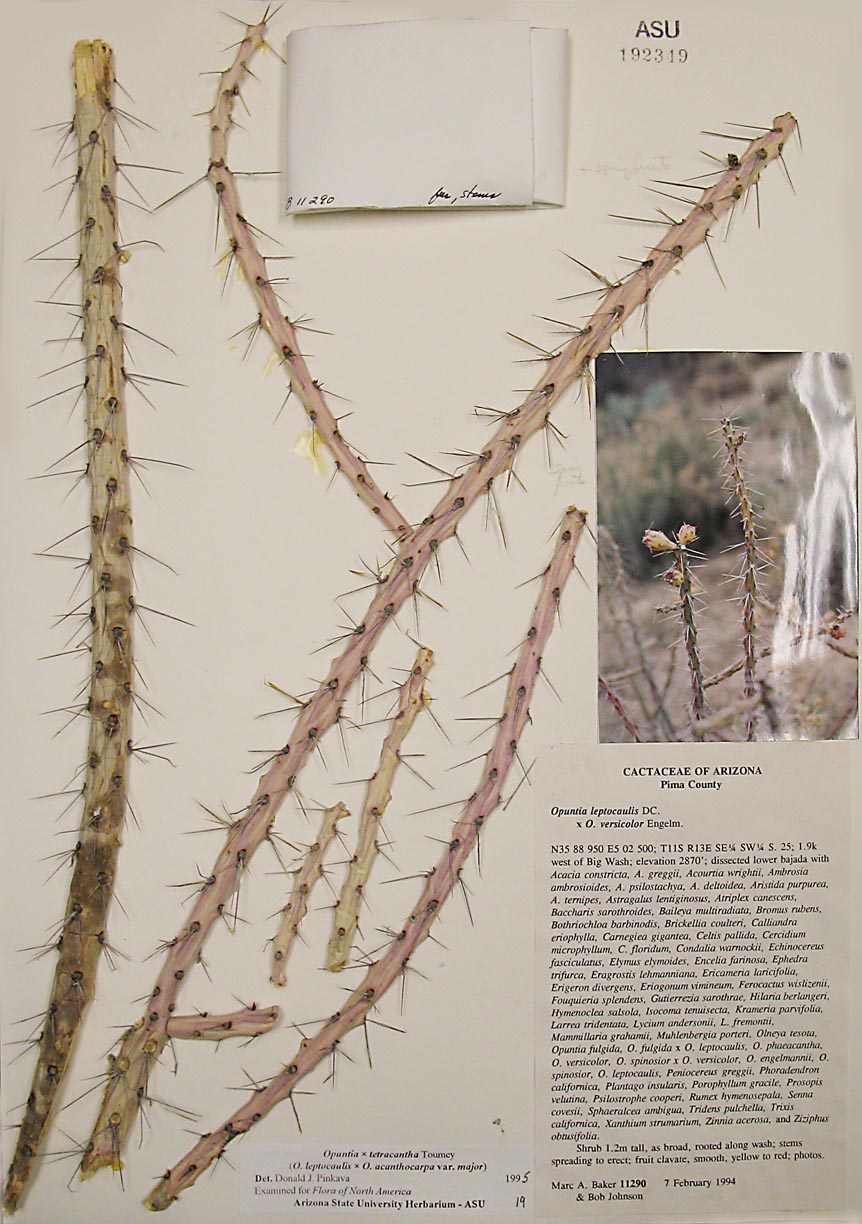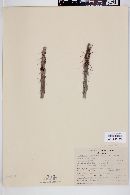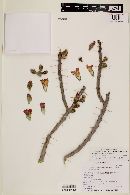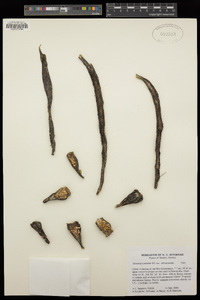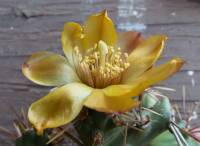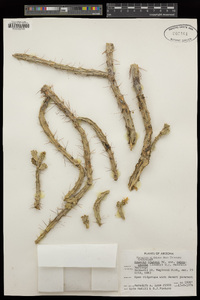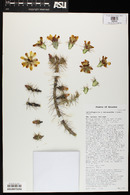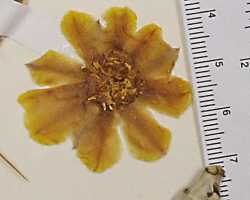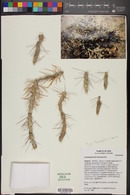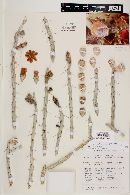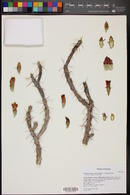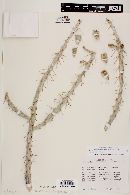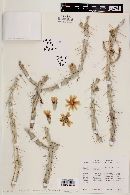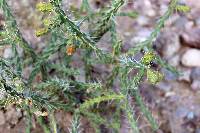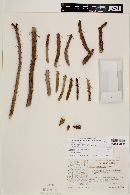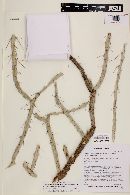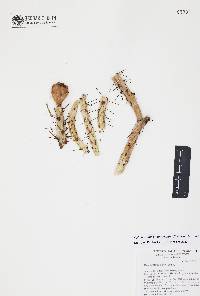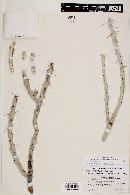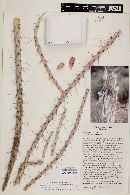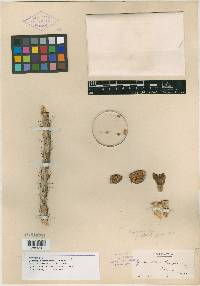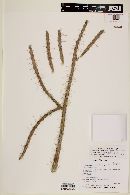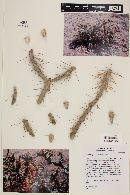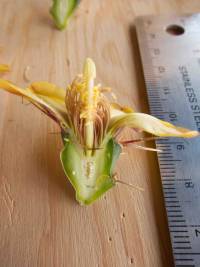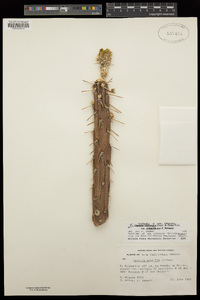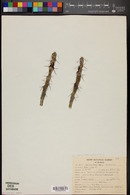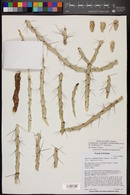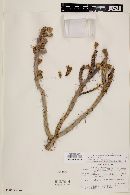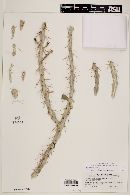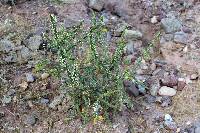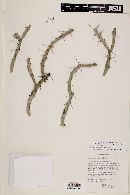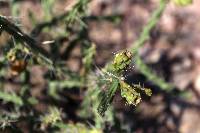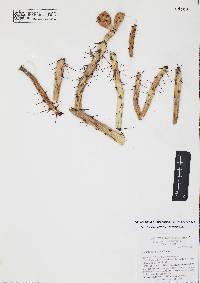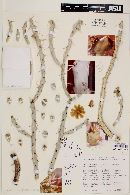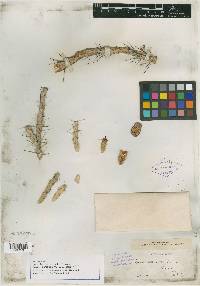Cylindropuntia x tetracantha
|
|
|
|
Family: Cactaceae
Tucson pricklypear, more...Tucson prickly-pear
[Opuntia californica Engelm., moreOpuntia kleiniae var. tetracantha (Toumey) W.T. Marsh., Opuntia tetracantha Toumey, Opuntia X tetracantha Toumey (pro sp.)] |
Shrubs, openly branched, 0.5-1.3 m. Stem segments usually alter-nate, green to gray-green (or reddish), 5-28 × 0.7-1.4 cm; tubercles moderately prominent, narrowly elongate, 1.5-3 cm; areoles subcircular, 1.5-3 mm in diam.; wool tan, aging gray. Spines (0-)1-4 per areole, in all but proximal areoles of stem segment, usually all deflexed, yellow with whitish to pinkish basal coating, moderately stout to acicular, the longest 1.5-2.8 cm; sheaths whitish at bases to golden at tips. Glochids in adaxial tuft and marginal about areole, yellow, 1-3 mm. Flowers: inner tepals greenish bronze or red to magenta, spatulate- to obovate-apiculate, 10-15 mm; filaments reddish; anthers light yellow; color of style and stigma lobes unknown . Fruits commonly sterile, often proliferating, green, becoming yellow with red blush to red, obconic to obovate-stipitate, 15-23 × 10-20 mm, fleshy, moderately tuberculate; umbilicus deep, 3-4.5 mm; areoles 10-18, a few producing 1(-2) short spines. Seeds tan, angularly subcircular to broadly oval, warped, 3-4 × 3-3.5 mm; girdle broad, lumpy, little protruding. 2n = 22. Flowering spring (Apr-May). Sonoran desert scrub, flats, hills; 500-1000 m; Ariz. Cylindropuntia ×tetracantha (= C. acanthocarpa × C. leptocaulis) is an uncommon hybrid; sympatric hybrids long confused with and usually included in C. ×tetracantha involve C. leptocaulis × C. spinosior, which have spineless, reddish, and strongly tuberculate fruits and long-spreading, subwhorled branches, and C. leptocaulis × C. versicolor, which have spineless, reddish, smooth, and enlarged fruits and a less spreading habit.
Plant: openly branched shrub, 0.5-1.3 m tall; STEM segments green to gray-green (or reddish), 5-28 cm long, 0.7-1.4 cm in diam.; tubercles moderately prominent, narrowly elongate, 1.5-3 cm long. AREOLES tan-felty, aging gray, subcircular, 1.5-3 mm in diam Leaves: SPINES in all but segment's basal areoles, yellow with whitish to pinkish basal coating, usually all deflexed, moderately stout to acicular, (0-)1-4 per areole, the longest 1.5-2.8 cm; sheaths whitish at bases to golden at tips. GLOCHIDS yellow, in apical tuft with a few encircling the areole, 1-3 mm. Flowers: inner tepals greenish bronze or red to magenta, spatulate- to obovate-apiculate, filaments reddish, the anthers light yellow; style and stigma colors unknown Fruit: commonly sterile, green becoming yellow with red blush to red, moderately tuberculate, a few areoles producing 1(-2) short spines, obconic to obovate-stipitate, fleshy, often proliferating, 1.5-2.3 cm long, 1--2 cm in diam.; umbilicus 3-4.5 mm deep; areoles 10-18. SEEDS 3-4 mm long, 3-3,5 mm wide, tan, angularly subcircular to broadly oval, warped with uneven sides, the girdle broad, lumpy, slightly protruding, 3-4 cm long, 3-3.5 mm wide Misc: Desert flats and hills, desertscrub; 550-1000 m (1800-3200 ft); Apr-May REFERENCES: Pinkava, Donald J. 1999. Cactaceae. Ariz. - Nev. Acad. Sci. 32(1). Benson 1969, Benson 1982, FNA 2003, Pinkava 1999 Common Name: Tucson pricklypear Duration: Perennial Protected Status: Salvage restriced status in Arizona. General: Sprawling to suberect shrub 0.5-1.3 m tall that is open and widely branching with alternate stem segments, the stems green to gray green and 5-28 cm long by 0.7-1.4 cm wide, with moderately prominent tubercles that are narrowly elongate and 1.5-3 cm. Spines: Bearing 1-4 spines per areole in all but lowest parts of the stem segment, usually all deflexed and yellow with whitish to pinkish basal coating, generally they are moderately stout to needle shaped. The sheaths whitish at base to golden at the tips with areoles that are subcircular and 1.5-3 mm diameter with a tan wool that ages gray, and yellow glochids in an apical tuft encircling the areole about 1-3 mm. Flowers: Inner tepals greenish bronze to red to magenta and 10-15 mm, spatulate to obovate near the tip with reddish filaments and light yellow anthers. Fruits: Commonly sterile, often proliferating and green but becoming yellow with red blush to red, they are obconic to obovate stipitate, 15-23 mm by 10-20 mm and fleshy with 10-18 areoles. Ecology: Found on desert flats, hills, and desert scrub from 1,500-3,500 ft (457-1067 m), flowers April-June. Notes: Looks similar to C. arbuscula but has many more prominent tubercles. Thought to be a hybrid of C. acanthocarpa and C. leptocaulis it can be confused with other hybrids, especially between C. leptocaulis and C. spinosior which is spineless, reddish and has strongly tuberculate fruits. Ethnobotany: Unknown Etymology: Cylindropuntia is from Greek kylindros or a cylinder, plus the genus Opuntia, while tetracantha is from the Greek tetra for four and akan tha for spine or thorn. Synonyms: Opuntia californica, Opuntia kleiniae var. tetracantha, Opuntia x tetracantha Editor: SBuckley, 2010 |
|
|
|

